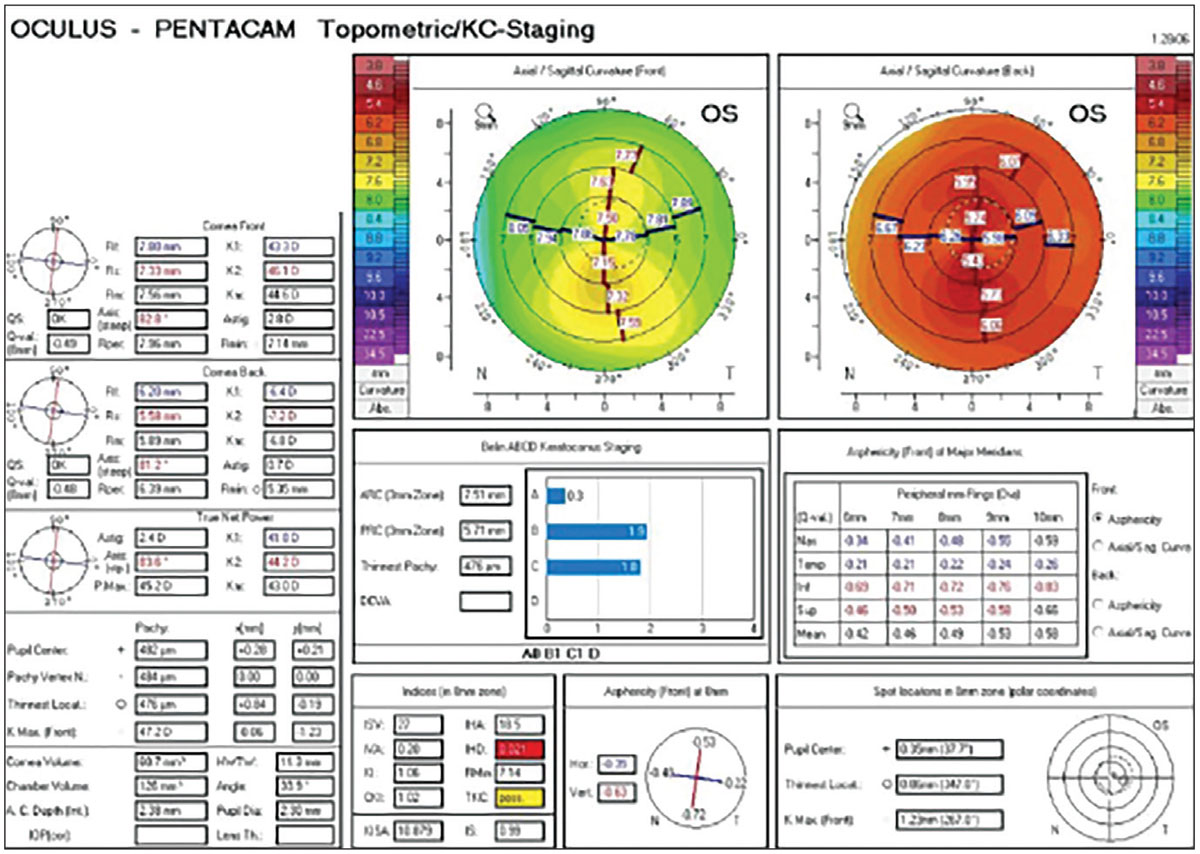 |
|
Children with clinical suspicion for keratoconus had a high rate of at least one indeterminate value on Scheimpflug imaging, and can be helpful markers in monitoring for subclinical disease over time. Photo: Julie Song, OD. Click image to enlarge. |
Keratoconus (KCN) in children typically progresses more rapidly than in adults, exposing kids to unstable vision during a critical developmental period. Late childhood is also when corneal crosslinking to mitigate KCN progression is most effective and optimal; the treatment is approved for use at ages 14 and up. As such, early detection remains vital to long-term outcomes. While Scheimpflug imaging devices (e.g., Pentacam) improve screening and give detailed data on corneal irregularities than can improve contact lens design, there are no established pediatric guidelines for use. Researchers from Chicago and Los Angeles recently aimed to correlate clinical factors with abnormal imaging results to aid in the development of screening protocols. They found that older age, lower visual acuity, oblique astigmatism and corneal findings were more commonly found in patients with abnormal screening Pentacam..
A total of 78 patients between the ages of three and 18 were screened for keratoconus with slit lamp examination, refraction and Scheimpflug imaging.
Three Scheimpflug indices associated with KCN progression were recorded for all subjects. Although 70% of patients had at least one abnormal or indeterminate value on such indices in their more severely affected eye, only 14% of screened patients showed keratoconus on all three. “Therefore, clinical suspicion (mostly high astigmatism) had a low specificity for identifying pediatric patients with a high likelihood of keratoconus on initial screening,” the authors wrote in their article on the work.
Notably, lower presenting CDVA was also associated with keratoconus values for all three indices. The average CDVA was 20/27 to 20/33 for normal and indeterminate values for each index and 20/67 to 20/85 for keratoconus values for each index.
Another factor associated with keratoconus on initial screening was older age, which was expected due to keratoconus progressing as children get older. A high likelihood of keratoconus did not develop before 11 years of age in patients without clinical risk factors “suggesting that screening with Pentacam in the earliest years of childhood may have low sensitivity in detecting keratoconus in those who have disease later on in adolescence or those with subclinical disease,” the authors wrote.
These findings are similar to a previous study that found that children under 14 years old had significantly different values on two KCN metrics by Pentacam compared to the ≤14 years age group. “It may therefore be reasonable to start screening with Scheimpflug imaging for children who have high astigmatism but no corneal abnormalities at the age of eight to nine years-old,” the authors wrote.
While the amount of astigmatism was not statistically significant between the groups, the type of astigmatism differed significantly, the authors noted. “There was a higher percentage of with-the-rule astigmatism and a lower rate of oblique astigmatism in normal and indeterminate values compared to keratoconus for all three indices,” the authors explained.
The patients in this cohort with clinical suspicion for keratoconus had a high rate of at least one indeterminate value on Scheimpflug imaging among the three indices. “These readings that are above normal range but not yet within keratoconus range can be helpful markers in monitoring for subclinical disease over time,” the authors concluded in their paper.
| Click here for journal source. |
Zhao SH, Berkowitz C, Ralay Ranaivo H, et al. Evaluation of parameters for early detection of pediatric keratoconus. BMC Ophthalmology. October 21, 2024. [Epub ahead of print.] |

